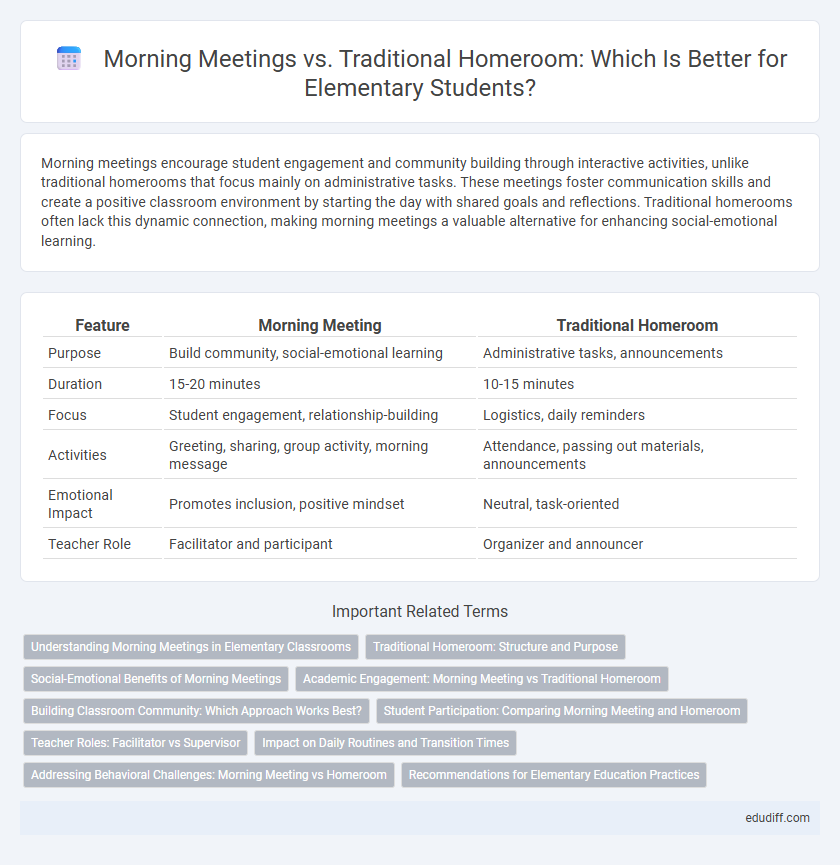Morning meetings encourage student engagement and community building through interactive activities, unlike traditional homerooms that focus mainly on administrative tasks. These meetings foster communication skills and create a positive classroom environment by starting the day with shared goals and reflections. Traditional homerooms often lack this dynamic connection, making morning meetings a valuable alternative for enhancing social-emotional learning.
Table of Comparison
| Feature | Morning Meeting | Traditional Homeroom |
|---|---|---|
| Purpose | Build community, social-emotional learning | Administrative tasks, announcements |
| Duration | 15-20 minutes | 10-15 minutes |
| Focus | Student engagement, relationship-building | Logistics, daily reminders |
| Activities | Greeting, sharing, group activity, morning message | Attendance, passing out materials, announcements |
| Emotional Impact | Promotes inclusion, positive mindset | Neutral, task-oriented |
| Teacher Role | Facilitator and participant | Organizer and announcer |
Understanding Morning Meetings in Elementary Classrooms
Morning meetings in elementary classrooms foster social-emotional learning and build community by encouraging student sharing and collaboration. Unlike traditional homerooms that focus mainly on administrative tasks and announcements, morning meetings emphasize relationship-building and interactive activities. Research shows morning meetings improve student engagement, behavior, and academic readiness throughout the school day.
Traditional Homeroom: Structure and Purpose
Traditional homeroom serves as a structured time for attendance, announcements, and preparing students for the day ahead. It provides a consistent setting where teachers establish routines, distribute materials, and address administrative tasks. This focused environment enhances classroom management and supports student readiness.
Social-Emotional Benefits of Morning Meetings
Morning Meetings foster a strong sense of community by encouraging daily student interaction, which enhances social-emotional skills such as empathy, self-regulation, and cooperation. Unlike Traditional Homerooms that primarily focus on administrative tasks, Morning Meetings integrate morning greetings, sharing, group activities, and discussions to build trust and improve communication. Research indicates that consistent Morning Meetings contribute to a positive classroom climate, reducing behavioral issues and increasing students' emotional resilience.
Academic Engagement: Morning Meeting vs Traditional Homeroom
Morning meetings boost academic engagement by fostering a sense of community and focus at the start of the day, encouraging active participation and collaboration among elementary students. Traditional homerooms often concentrate on administrative tasks, resulting in less direct engagement with academic content and peer interaction. Research shows that classrooms using morning meetings experience higher student motivation and improved attention during lessons.
Building Classroom Community: Which Approach Works Best?
Morning Meeting emphasizes building a strong classroom community through daily rituals such as greeting, sharing, and group activities, fostering student connection and social-emotional growth. Traditional Homeroom often centers on administrative tasks, offering limited time for meaningful interactions that create a supportive environment. Research shows that Morning Meeting significantly enhances student engagement and a sense of belonging, making it a more effective approach for developing positive classroom culture.
Student Participation: Comparing Morning Meeting and Homeroom
Morning Meetings significantly increase student participation by fostering a structured, interactive environment where students share thoughts, set goals, and build community. Traditional homerooms typically involve passive activities such as attendance and announcements, resulting in lower engagement levels. Research indicates that Morning Meetings enhance social-emotional learning and encourage active student involvement compared to traditional homeroom routines.
Teacher Roles: Facilitator vs Supervisor
In morning meetings, teachers act as facilitators by encouraging student participation, fostering a collaborative classroom environment, and guiding discussions to build social skills and community. Traditional homeroom teachers primarily serve as supervisors, managing attendance, discipline, and administrative tasks with less emphasis on interactive student engagement. This shift from supervisory to facilitative roles supports stronger teacher-student relationships and promotes a positive classroom culture.
Impact on Daily Routines and Transition Times
Morning Meeting structures promote smoother transitions by establishing clear routines that engage students immediately, reducing downtime between activities. Traditional homeroom often lacks interactive elements, leading to longer transition periods and less focused starts to the day. Implementing Morning Meeting can enhance overall classroom efficiency and improve student readiness for daily lessons.
Addressing Behavioral Challenges: Morning Meeting vs Homeroom
Morning Meeting creates a structured space for students to express feelings and develop social skills, which helps reduce disruptive behaviors before instruction begins. Traditional Homeroom often focuses on administrative tasks, leaving less time to proactively address behavioral challenges. Implementing Morning Meeting practices leads to improved classroom climate and fewer behavior issues throughout the day.
Recommendations for Elementary Education Practices
Morning Meeting fosters social-emotional learning, promoting a strong sense of community and student engagement unlike traditional homeroom, which often focuses on administrative tasks. Educators should implement Morning Meetings daily to enhance communication, collaboration, and positive behavior in elementary classrooms. Incorporating structured greetings, sharing, group activities, and morning messages supports student readiness and boosts overall academic success.
Morning Meeting vs Traditional Homeroom Infographic

 edudiff.com
edudiff.com